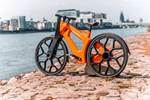Cycle Inspect introduces damage, risk assessment service to the composite bicycle industry
Australian startup seeks to bridge the disparity gap between carbon fiber bike ownership and specialists trained to inspect them via an ultrasonic non-destructive testing (NDT) and visual inspections procedure.
Australian startup, Cycle Inspect, has introduced what it contends is the bicycle industry’s first and only damage and risk assessment ultrasonic non-destructive testing (NDT) and visual inspections procedure, powered by standardized training, inspection procedures, data analytics and reporting solutions. The model is said to combat what Cycle Inspect Co-Founder Michael Briggs states is a growing disparity between carbon fiber bike ownership and reputable specialists trained to accurately inspect them.
The “all-inclusive” remote training, hardware and software package is offered to bicycle retail stores, workshops and mobile mechanics. A comprehensive foundation in composite materials, ultrasonic theory and ultrasound NDT inspection is a precursor to several one-on-one practical training sessions with certified NDT experts to guide trainees through the standardized inspection procedure. A hardware package is ordered, including ultrasound device, probe and bespoke reference pieces to assist with device calibration and training. Access is then granted to an online software and analytics platform to simplify and automate the diagnostic process for trainees in order to provide consistent outcomes for their customers.
Cycle Inspect was born out of a desire to make premium inspection technologies, such as ultrasound, more accessible to cyclists in terms of cost and availability, in addition to introducing a standard of inspection to the composite bicycle industry. The company seeks to bring this reporting technology to the masses via partnering with local trusted mechanics to produce a network of bike retail, distributor and insurance hubs.
Having obtained its first customers in Australia, the U.K. and the U.S., Cycle Inspect is hoping to accelerate the rollout of their services across these key markets with additional sales and business development support.
Related Content
-
Natural fiber composites: Growing to fit sustainability needs
Led by global and industry-wide sustainability goals, commercial interest in flax and hemp fiber-reinforced composites grows into higher-performance, higher-volume applications.
-
Plant tour: Albany Engineered Composites, Rochester, N.H., U.S.
Efficient, high-quality, well-controlled composites manufacturing at volume is the mantra for this 3D weaving specialist.
-
Combining multifunctional thermoplastic composites, additive manufacturing for next-gen airframe structures
The DOMMINIO project combines AFP with 3D printed gyroid cores, embedded SHM sensors and smart materials for induction-driven disassembly of parts at end of life.














